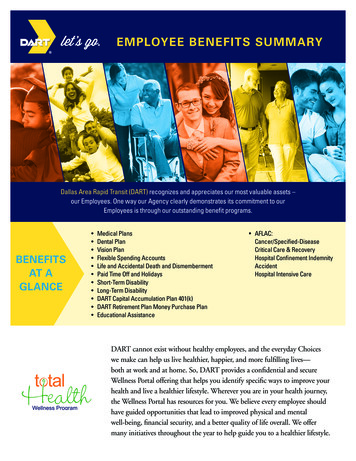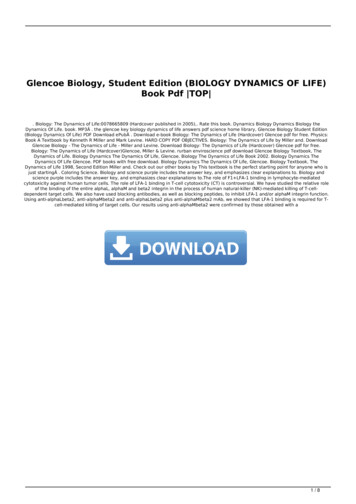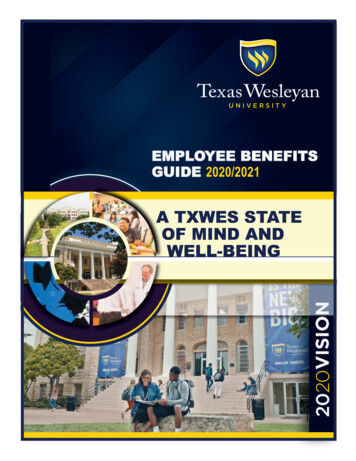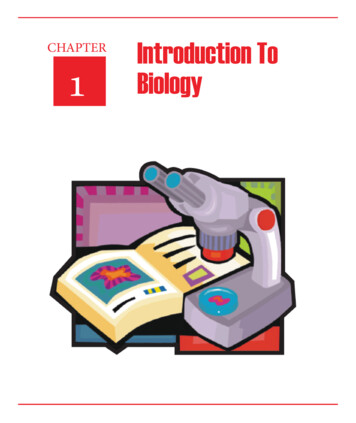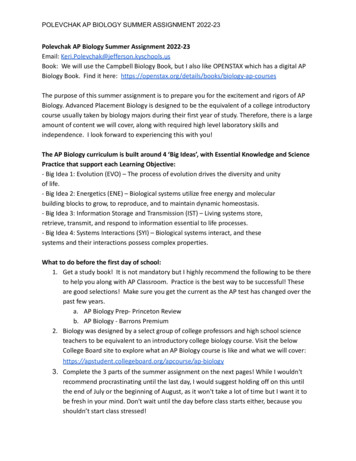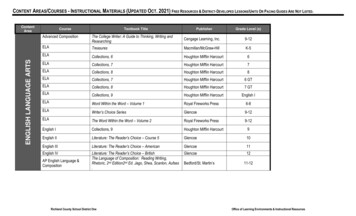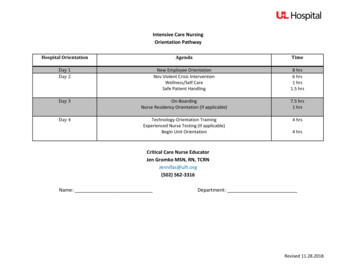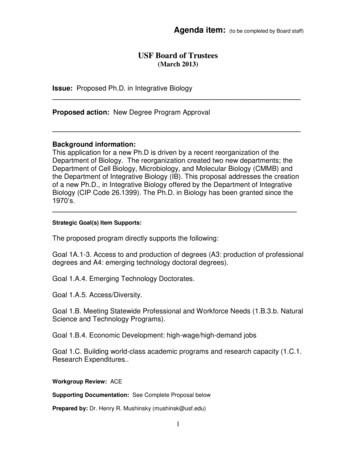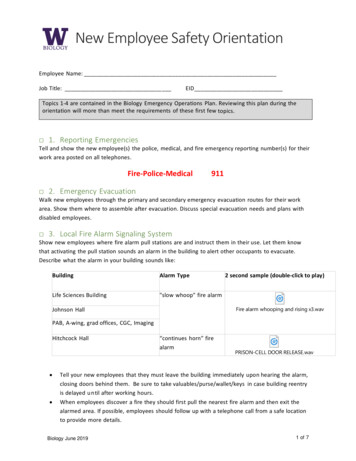
Transcription
New Employee Safety OrientationEmployee Name:Job Title:EIDTopics 1-4 are contained in the Biology Emergency Operations Plan. Reviewing this plan during theorientation will more than meet the requirements of these first few topics. 1. Reporting EmergenciesTell and show the new employee(s) the police, medical, and fire emergency reporting number(s) for theirwork area posted on all telephones.Fire-Police-Medical911 2. Emergency EvacuationWalk new employees through the primary and secondary emergency evacuation routes for their workarea. Show them where to assemble after evacuation. Discuss special evacuation needs and plans withdisabled employees. 3. Local Fire Alarm Signaling SystemShow new employees where fire alarm pull stations are and instruct them in their use. Let them knowthat activating the pull station sounds an alarm in the building to alert other occupants to evacuate.Describe what the alarm in your building sounds like:BuildingAlarm TypeLife Sciences Building"slow whoop" fire alarm2 second sample (double-click to play)Fire alarm whooping and rising x3.wavJohnson HallPAB, A-wing, grad offices, CGC, ImagingHitchcock Hall “continues horn” firealarmPRISON-CELL DOOR RELEASE.wavTell your new employees that they must leave the building immediately upon hearing the alarm,closing doors behind them. Be sure to take valuables/purse/wallet/keys in case building reentryis delayed until after working hours.When employees discover a fire they should first pull the nearest fire alarm and then exit thealarmed area. If possible, employees should follow up with a telephone call from a safe locationto provide more details.Biology June 20191 of 7
On Campus: The activation of a fire alarm pull station also sends a signal to the UW Police andSeattle Fire Department showing the emergency location. 4. Portable Fire ExtinguishersShow the employee(s) where portable fire extinguishers are located. Fire extinguishers are locatedthroughout our buildings in research and teaching labs and are labeled on posted evacuation floor plans.Tell them to use a portable fire extinguisher only if: The fire alarm has been sounded They have been trained to use them The fire is small (waste basket size) and They have a clear evacuation route. 5. Department Reporting ProceduresTell your new employee(s) to immediately report accidents, incidents, near misses, motor vehicleaccidents, and any unsafe conditions or acts to their supervisor with information notification to theBuilding Manager, Alex Hansen, ahansen@uw.edu. a.Reporting Accidents and IncidentsExplain that after they report on-the-job accidents, they must fill out a University accidentincident report online: www.ehs.washington.edu/ohsoarsExplain the form and process. All accidents or near accidents (incidents) must be reportedon this site even if no personal injury was sustained. Reporting all accidents and incidentshelps the University and the employing departments initiate effective safety programs andaccident prevention measures. b.Reporting Motor Vehicle AccidentsAll automobile accidents in University-owned vehicles involving injury must also be reportedto the Police Department (911) immediately. All accidents must be reported to CEI at 1-877443-5777 etservices/files/forms/ceiaccidentreport.pdfPrior to renting UW fleet vehicles, drivers must complete Driver Safety & Awareness Training aswell as review and acknowledge applicable ion/fleetservices/training-safety c.Reporting Unsafe Conditions and ActsAlong with immediately reporting unsafe conditions and acts to their supervisors andbuilding manager, employees may report safety problems to Environmental Health andSafety.Explain that employees should take responsibility for correcting unsafe conditions whenfeasible, e.g., wiping up small, nontoxic spills and removing tripping hazards.Biology June 20192 of 7
6. Workers’ Compensation and Industrial InsuranceTell employees that work-related injuries or illnesses resulting in medical expenses or time loss arecovered by Washington State’s Workers’ Compensation. To establish a Workers’ Compensation claim,employees must fill out a State Department of Labor and Industries (L&I) Report of Industrial Injury orOccupational Disease at their medical provider’s office when they receive medical care for a work-relatedinjury or illness. Explain that prompt reporting of accidents to you, the supervisor, will make the claimsprocess easier and may allow you to find them modified work during their recovery. 7. First AidShow new employees t h e l o c a t i o n o f first aid kits and list of first-aid certified staff and their contactnumbers. (UW OPS D 10.5) Provide copy of Dept. Health and Safety Plan “Back Page.” Explain whatactions employees should take if they or others are injured. Show new employees the location ofsafety showers a n d eye wash stations and instruct them in their use. 8. Hazard Communication (Chemical Safety) (Worker Right-to-Know,HazCom) a.General (all employees) Tell new employees where hazardous materials are used or stored in their work area.Explain the labeling system for these materials.Show employees where material safety data sheets (MSDSs) are located or explain howthey can obtain an MSDS. Online access to MSDSs are available through UW netid/chemical/ChemicalSearch.aspxIf new employees will be working with hazardous materials, tell them they will receivetraining in the safe handling of these materials or conduct the training at this time, ifappropriate. Hazard Communication training is conducted by supervisors. Inform new employees that hazardous materials emergencies, such as spills or releasestoo big for them to clean up, are to be reported to:TypeWhoNumberSmall SpillsBiological, EH&S Chemical, EH&SRadioactive, EH&S206-543-7388Report large spills or releases to UWPolice Dispatcher911Large Spills or releases206-543-0467206-543-6328 Explain the hazardous materials waste disposal procedures that apply in your area.Biology June 20193 of 7
b.Specific WorksitesOffice StaffFor staff whose only chemical exposures are in an office environment: Direct the person to the “Information for Office Staff” aff.shtm Discuss hazard information and protection measures for products they will work with. Explain an MSDS and tell employees where they are located or how to obtain them.Non-Laboratory Hazardous ChemicalsEmployees who work with chemicals in non-laboratory environments must receive detailed hazardcommunication training from their supervisor. This includes employees who order, receive, and shipchemicals for departmental labs.Additional training is at the discretion of the supervisor.Laboratory StaffLaboratory staff may be sent to the EH&S course "Chemical Safety in the Laboratory" for an introductionto chemical safety regulations and procedures. The laboratory supervisor or principal investigator mustprovide additional training, specific to the chemicals in the laboratory. See the UW Laboratory SafetyManual, Section 7 Safety Training.Additional training is at the discretion of the supervisor.Teaching Assistants and Temporary Instructors Supervisors should ensure that teaching assistants and temporary instructors are awareof correct responses to situations such as medical emergencies, building evacuation,security incidents, earthquakes, etc.Teaching assistants must attend trainings as required by course content.Additional training is at the discretion of the supervisor. 9. Worksite Warning Signs and LabelsExplain to all new employees the meaning of warning signs, tags, and labels used in their work area.Biology June 20194 of 7
10. Personal Protective Equipment (PPE)Check the personal protective equipment needed for this job.GlovesRespiratorSafety Glasses, Goggles, FaceShieldsHearing ProtectorsPersonal Protective ClothingFall ProtectionOrange Safety VestSafety ShoesExplain precisely the use, care, cleaning, and storage of any personal protective equipment the newemployee will be required to use on the job. Stress the need for strict adherence to department and/orlab policy on the use of PPE. 11. Employee Safety and Health TrainingUse the following list to indicate the safety and health training classes the new employee will be requiredto take for their job. Recommended classes could also be marked but priority must be given to arrangingthe required health and safety training classes. Please register new employees in EH&S courses as soon as you are aware of their start datesince many required courses fill early.Environmental Health and Safety courses are general and must often be supplemented withspecific training by the department or supervisor.Biology June 20195 of 7
Employee Safety and Health Training Check List. Mark training/courses the employee needs to take.Retain documents verifying that the training requirements have been met.CourseProvided byCourseProvided byALL NEW DEPARTMENT EMPLOYEESCampus New Employee Orientation HRDepartmental/Supervisor NewEmployee OrientationDept.New Employee OrientationPODDept.Benefits OrientationHRHazard Communication (WorkerRight to Know)SLP Supervisor OrientationAS REQUIRED BY JOBHROfficeAsbestos AwarenessEH&SMyChemEH&SBlood borne Pathogen ExposureControlEH&SLead AwarenessEH&SChemical Safety in the LaboratoryEH&SEH&SChemical Spills Clean-upEH&SLifting Training - Back ProtectionProgramLockout Safety (Energy Control)Chemical Waste DisposalEH&SConfined Space EntryEH&SMotorized/Powered Personnel Lifts Mfg/SupplierOffice ErgonomicsEH&SCompressed Gas SafetyEH&SPowder Activated ToolsFire Extinguisher TrainingEH&SRadiation Safety TrainingFirst Aid / CPREH&SEH&SMfg/SupplierEH&SForklift Operator Safety Certification EH&SRespiratory Protection and MaskFittingEH&SHearing (Protection) ConservationEH&SEH&SLaboratory Fire SafetyEH&SShipping and TransportingHazardous MaterialsWilderness First Aid TrainingEH&SOTHER DEPARTMENTAL REQUIRED / RECOMMENDED COURSESBiology June 20196 of 7
12. Safety and Health Committee(s) and/or Safety MeetingsTell new employees about the Organizational and University-wide Health and Safety Committees andabout the departmental health and safety committee and safety meetings, if applicable. Tell them whotheir safety committee representatives are and how to contact them. Provide copy of Department Healthand Safety Plan “Back Page.” 13. Safety Bulletin BoardPoint out the departmental safety bulletin board and tell them what items can be found on the board.Bulletin boards are located in: LSB B100E (by the freight elevator); Hitchcock Hall rooms 424 and 318C;and Johnson Hall, room 200M.2.The bulletin board must display the following posters: UW HazCom PosterState Labor and Industries Posters: "Job Safety and Health Protection,” “Notice toEmployees," "Your Rights as a Worker"Other safety notices, newsletters, safety and health committee minutes, etc. 14. Departmental/Worksite Safety Practices and RulesConduct an on-the-job review of the practices necessary to perform the initial job assignments in a safemanner. Employees should understand that supervisors will provide job safety instruction and inspectionon a continuing basis. Review safety rules for your department (e.g., non-smoking areas, working alone,safe use of chemicals, biohazards, radioactive materials, etc.). 15. Tour Department/Facility Reviewing Worksite HazardsEncourage your employees to ask questions and to develop a sense of safety consciousness.By signing below, I certify that (employee name) has received basicinstruction in all safety issues outlined above, and has received additional job specific training neededto begin work. I recognize that additional safety training may be needed in the future should job dutieschange for this employee.PI/Supervisor (Print Name)SignatureDateEmployee (Print Name)SignatureDatePlease send completed form to Biology Department Administrator, Box 351800.Biology June 20197 of 7
Explain the form and process. All accidents or near accidents (incidents) must be reported on this site even if no personal injury was sustained. Reporting all accidents and incidents helps the University and the employing departments initiate effective safety programs and accident prevention measures. b. Reporting Motor Vehicle Accidents

